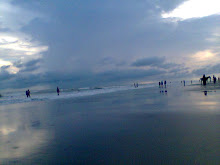
This large image, which comes from Sankarbandha near Ramapal in the Dhaka district, is represented with weapon wielding ten hands, which are swinging in the dancing rhythm of the god. Its elaborate backing and pedestal are also conceptually rich. These two forms of dancing images of Siva-Nataraja and Ganesa lead us into the twelfth century art of Bengal.
The twelfth century images, irrespective of their being in stone or bronze, represent the last and final phase of the East Indian sculpture. The style of this phase is an extension, elaboration and proliferation of that of the eleventh century. But a change in aesthetic emphasis is recognized in the style, effected chiefly by a political phenomenon that had serious impact on the socio-political life of the people of Bengal. In the beginning of the century the Senas, who hailed from Karnataka, displaced the Palas as rulers from the most parts of Bengal proper. They brought with them the orthodox social and religious practices of the Brahmanical faith; and as its result images of the Puranic deities, such as Visnu, Shiva, Shakti, Surya and Ganesha were numerously produced. Besides, several minor deities like Kartikeya, Sarasvati, Manasa and Ganga were given importance. Brahma, once a major divinity, was represented, too. All these images, as also those of the Mahayana-Tantrayana Buddhist gods and goddesses, introduced certain new composition of forms. But their stylistic distinction from those of the eleventh century's are marked not that much in the shapes of the images as in their overburdening ornamentation. The elaborate and overwhelming decorative motifs on the pedestal and the aureole became so dominating that the principal figure, the deity itself, appeared subservient to them.
The aureoles were now covered with the attending divinities, lion-on-elephants, swans, kinnaras and kinnaris, gandharvas and gandharvis, and finally at the top by the kirtimukha, a face of a mythical animal. The Senas, who were accustomed to it in their homeland Karnataka, introduced the last member kirtimukha in the Bengal art as a decorative feature. Occasionally architectural motifs, such as the façade of a temple or a stupa came to occupy the aureoles. The pedestals also grew more ornate and ratha projections increased in number, ranging from five to eleven. Undulating creepers and reptiles were introduced to cover the faces of the ratha planes, and in between their coils appeared floral as well as anthropomorphic forms. As a result the pedestals of multi-planes lost their sharp angles and became semi-circular in shape. But a more interesting change is noted in the cutting out of the backstone along the contour of the figure of the main deity, effecting fully rounded plastic forms in place of high reliefs, and succeeding in turning the aureole to a real halo or prabhamandala by providing for a light from behind. This device, initiated possibly in the late eleventh century, gave the images of the final phase a new stylistic dimension. (15 0f 16)
The twelfth century images, irrespective of their being in stone or bronze, represent the last and final phase of the East Indian sculpture. The style of this phase is an extension, elaboration and proliferation of that of the eleventh century. But a change in aesthetic emphasis is recognized in the style, effected chiefly by a political phenomenon that had serious impact on the socio-political life of the people of Bengal. In the beginning of the century the Senas, who hailed from Karnataka, displaced the Palas as rulers from the most parts of Bengal proper. They brought with them the orthodox social and religious practices of the Brahmanical faith; and as its result images of the Puranic deities, such as Visnu, Shiva, Shakti, Surya and Ganesha were numerously produced. Besides, several minor deities like Kartikeya, Sarasvati, Manasa and Ganga were given importance. Brahma, once a major divinity, was represented, too. All these images, as also those of the Mahayana-Tantrayana Buddhist gods and goddesses, introduced certain new composition of forms. But their stylistic distinction from those of the eleventh century's are marked not that much in the shapes of the images as in their overburdening ornamentation. The elaborate and overwhelming decorative motifs on the pedestal and the aureole became so dominating that the principal figure, the deity itself, appeared subservient to them.
The aureoles were now covered with the attending divinities, lion-on-elephants, swans, kinnaras and kinnaris, gandharvas and gandharvis, and finally at the top by the kirtimukha, a face of a mythical animal. The Senas, who were accustomed to it in their homeland Karnataka, introduced the last member kirtimukha in the Bengal art as a decorative feature. Occasionally architectural motifs, such as the façade of a temple or a stupa came to occupy the aureoles. The pedestals also grew more ornate and ratha projections increased in number, ranging from five to eleven. Undulating creepers and reptiles were introduced to cover the faces of the ratha planes, and in between their coils appeared floral as well as anthropomorphic forms. As a result the pedestals of multi-planes lost their sharp angles and became semi-circular in shape. But a more interesting change is noted in the cutting out of the backstone along the contour of the figure of the main deity, effecting fully rounded plastic forms in place of high reliefs, and succeeding in turning the aureole to a real halo or prabhamandala by providing for a light from behind. This device, initiated possibly in the late eleventh century, gave the images of the final phase a new stylistic dimension. (15 0f 16)

No comments:
Post a Comment